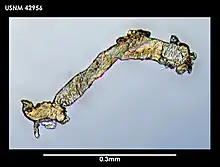| Scottnema lindsayae | |
|---|---|
 | |
| Holotype specimen | |
| Scientific classification | |
| Domain: | Eukaryota |
| Kingdom: | Animalia |
| Phylum: | Nematoda |
| Class: | Chromadorea |
| Order: | Rhabditida |
| Family: | Cephalobidae |
| Genus: | Scottnema |
| Species: | S. lindsayae |
| Binomial name | |
| Scottnema lindsayae Timm, 1971[1] | |
Scottnema lindsayae is a species of nematode belonging to the family Cephalobidae.[2][3] First described in 1971, it is endemic to Antarctica and most commonly found in the McMurdo Dry Valleys. S. lindsayae, a microscopic worm, feeds on microbes, including bacteria, yeast, and algae.[4] Adapted to very cold and dry climates, its population may be decreasing as a result of climate change.[5][6]
Taxonomy
S. lindsayae is the only described member of Scottnema.[3] Originally described by R. W. Timm (1971), it was named after the polar explorer Robert Scott and the collector of the holotype specimen, Kay Lindsay.[1]
Description and lifecycle
S. lindsayae is between half a millimeter and a millimeter in length and between two and four micrometers in width. S. lindsayae reproduces sexually, with females laying eggs. The minimum observed lifecycle length at 10 °C (50 °F) is 218 days, with four juvenile stages outside of the egg. As it enters hibernation during Antarctic winters, S. lindsayae likely needs more than one summer to complete one lifecycle. Temperatures above 10 °C (50 °F) were harmful to its reproductive cycle, with development being significantly impaired at 15 °C (59 °F).[7] As a result, significantly warming temperatures in Antarctic may pose a threat to this species.[7] In 2006, the population had decreased by 65% since 1993.[8]
Habitat
.jpg.webp)
S. lindsayae is one of three nematodes found in the soil of the McMurdo Dry Valleys, and the only one endemic to the continent. It has also been found in other parts of Antarctica, including East Ongul Island and Admiralty Bay. In the dry valleys, S. lindsayae is the dominant nematode, representing about 80% of the worms recorded, especially in the colder and drier parts where other species often cannot be found.[9] It is also more common at higher altitudes.[10][11] Found as far south as 83.48 degrees, it is the southernmost worm species recorded.[3]
References
- 1 2 Timm, R. W. (January 1971). "Antarctic soil and freshwater nematodes from the McMurdo Sound region" (PDF). Proceedings of the Helminthological Society of Washington. 38: 42–52 [43].
- ↑ "Scottnema lindsayae Timm, 1971". Global Biodiversity Information Facility. Retrieved 23 October 2022.
- 1 2 3 Adams, B. J.; Wall, D. H.; Gozel, U.; Dillman, A. R.; Chaston, J. M.; Hogg, I. D. (2007-06-01). "The southernmost worm, Scottnema lindsayae (Nematoda): diversity, dispersal and ecological stability". Polar Biology. 30 (7): 809–815. doi:10.1007/s00300-006-0241-3. S2CID 34662829.
- ↑ Boström, Sven; Holovachov, Oleksandr; Nadler, Steven A. (2011). "Description of Scottnema lindsayae Timm, 1971 (Rhabditida: Cephalobidae) from Taylor Valley, Antarctica and its phylogenetic relationship". Polar Biology. 34 (1): 1–12. doi:10.1007/s00300-010-0850-8. S2CID 18480936.
- ↑ "Climate change imperils tiny animal in the world's most extreme continent". Mongabay Environmental News. 2018-03-07. Retrieved 2022-09-14.
- ↑ Guiden, Mary (2018-01-05). "In Antarctic dry valleys, early signs of climate change-induced shifts in soil". College of Natural Sciences. Retrieved 2022-09-27.
- 1 2 Overhoff, Andreas; Freckman, Diana W.; Virginia, Ross A. (1993-04-01). "Life cycle of the microbivorous Antarctic Dry Valley nematode Scottnema lindsayae (Timm 1971)". Polar Biology. 13 (3): 151–156. doi:10.1007/BF00238924. ISSN 1432-2056. S2CID 23411142.
- ↑ Haag, Amanda Leigh (2006-11-21). "An Antarctic Ecosystem Shows Signs of Trouble as a Tiny Worm Turns". The New York Times. ISSN 0362-4331. Retrieved 2022-09-14.
- ↑ Freckman, Diana W.; Virginia, Ross A. (1997). "Low-diversity Antarctic soil nematode communities: distribution and response to disturbance". Ecology. 78 (2): 363–369. doi:10.2307/2266013. JSTOR 2266013.
- ↑ Zawierucha, Krzysztof; Marshall, Craig J.; Wharton, David; Janko, Karel (2019-05-07). "A nematode in the mist: Scottnema lindsayae is the only soil metazoan in remote Antarctic deserts, at greater densities with altitude". Polar Research. 38: 3494. doi:10.33265/polar.v38.3494. S2CID 164807375.
- ↑ "McMurdo Dry Valleys Long-Term Ecological Research". www.nsf.gov. Retrieved 2022-09-14.